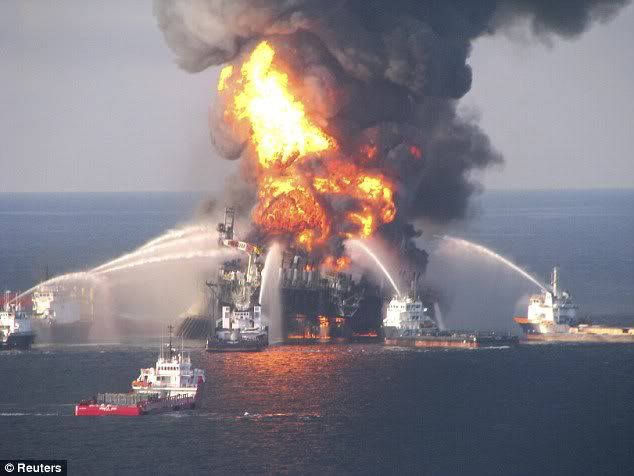
Ablaze: A fleet of tugs attempt to extinguish the fire on the sinking oil rig Deepwater Horizon, off Louisiana

No way to stop it: Rough winds and waves push against an oil boom set up in a flimsy effort to protect the Louisiana coast yesterday
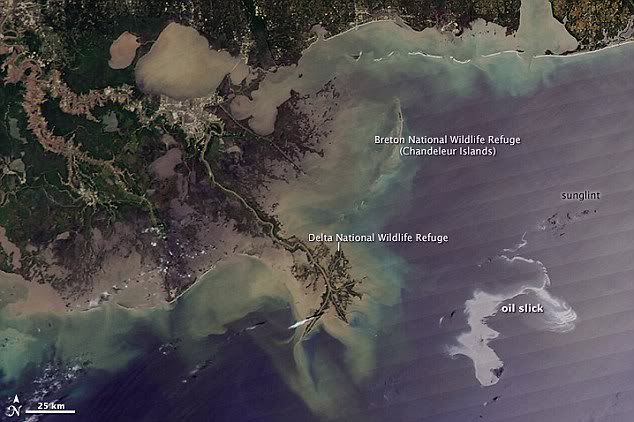
Snapshot of disaster: Four hundred miles out in space, Nasa's Aqua satellite has taken pictures of the oil slick in the Gulf of Mexico
Fishermen rushed to scoop up shrimp and crews spread floating barriers around marshes in a desperate attempt to stave off an environmental disaster.
BP was also facing financial disaster as the company lost £16.9billion in market value and U.S. President Barack Obama announced they will foot the bill for the clean-up.
The company is currently bleeding £4million a day as the crisis spreads out of control. In the end, the disaster could cost billions.
But the threat to life along the Louisiana coast - and the devastating repercussions for the local economy - threatened to be even greater.
The spill was bigger than imagined - and closer. Five times more oil than BP estimated is gushing into the ocean each day – about 5,000 barrels, or 210,000 gallons.
Fingers of oily sheen were reaching the Mississippi River delta, lapping the Louisiana shoreline in long, thin lines. The slick is estimated to be 600 miles in circumference and is set to devastate hundreds of miles of coastline.
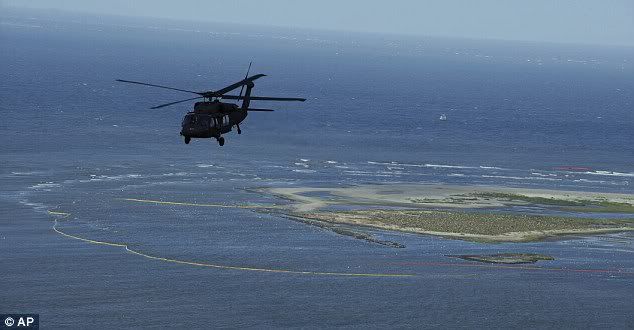
Hopeless: A helicopter flies over an oil boom ringing the islands of the Mississippi delta yesterday
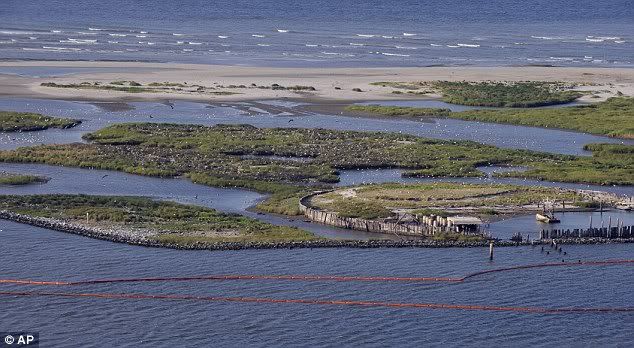
Last line of defence: The flimsy oil booms are now all that stands between the birds and other marine life here on Breton Island and along hundreds of miles of the Gulf Coast, and the lethal tar

No way to stop it: Rough winds and waves push against an oil boom set up in a flimsy effort to protect the Louisiana coast yesterday

Time running out: The survival of much wildlife on the coast is at stake as the spill threatens to turn bigger than the Exxon Valdez
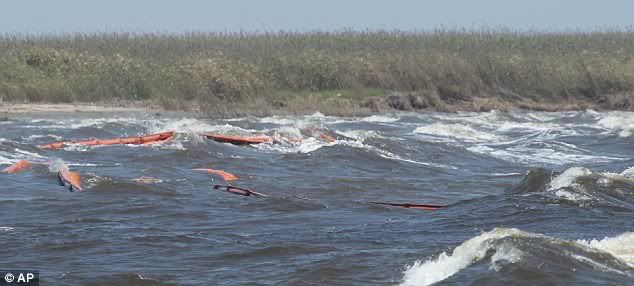
Stemming the tide: Waves swamp an oil boom set up off the coast yesterday. The weather has driven the slick onto the shoreline much earlier than anticipated - and if the waves continue to pound the booms they fail to catch much of the oil
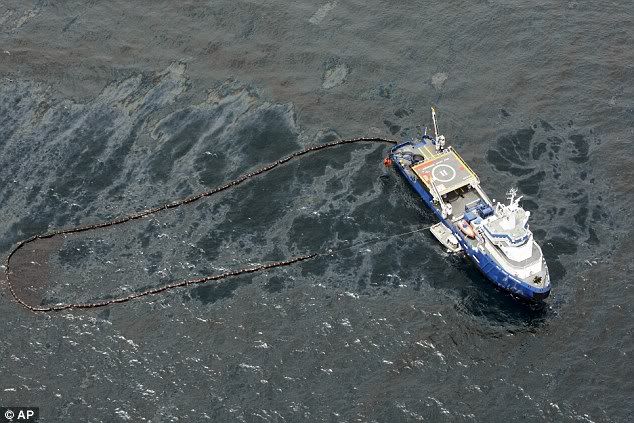
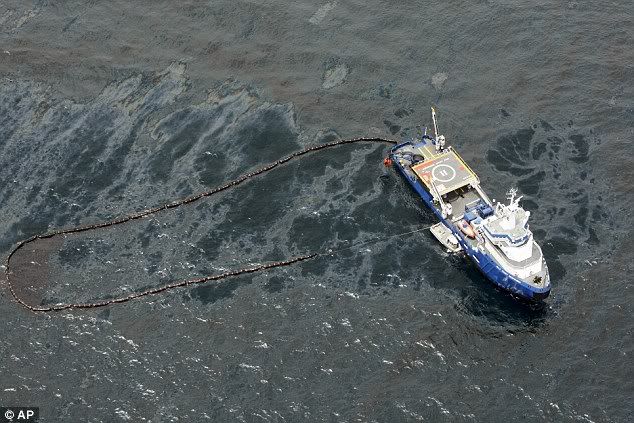
Threat: A boat tries to scoop up some of the spill using an oil boom
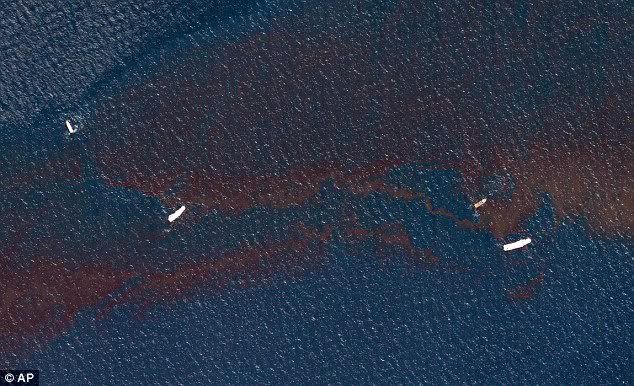
The DigitalGlobe images clearly show the oil slick floating on the surface of the water as clean-up crews attempt to stem the flow
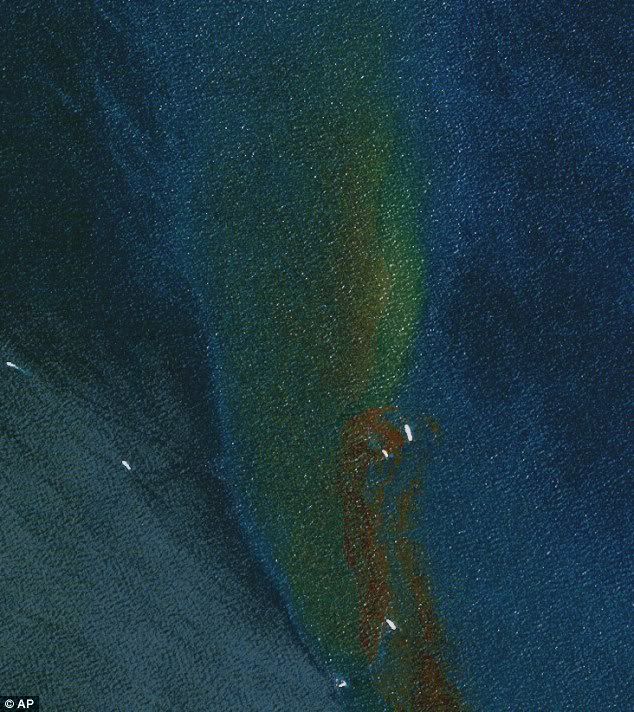
Lethal: A satellite image taken on Monday by DigitalGlobe shows vessels working to clean up the oil slick
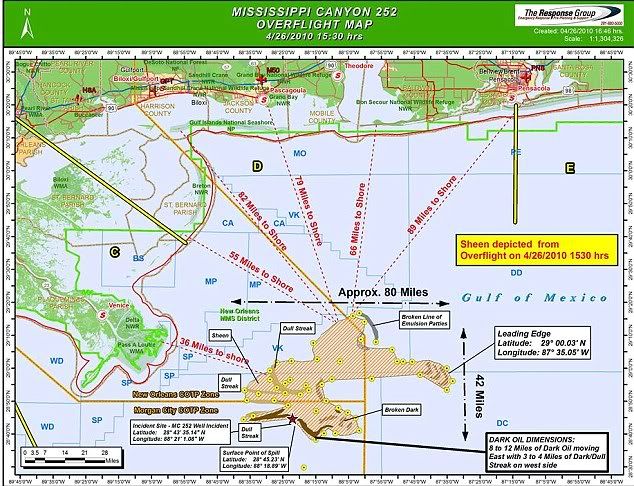
A graphic posted by the U.S. coastguard and the industry task force fighting the slick shows its approximate location
'It is of grave concern,' David Kennedy of the National Oceanic and Atmospheric Administration, said.
'I am frightened. This is a very, very big thing. And the efforts that are going to be required to do anything about it, especially if it continues on, are just mind-boggling.'
President Obama has offered military planes, ships and equipment to help BP stem the oil spewing from a well beneath the rig which exploded and sank in the Gulf of Mexico last week.
And the cost of cleaning it up will fall on London-based firm BP, the White House said yesterday.
Barack Obama's spokesman Nick Shapiro said the President has ordered his administration to aggressively confront the oil slick that is spreading over the Gulf of Mexico and oozing ever closer to the coast.
The military is working to determine how its array of aircraft, ships and equipment might be able to assist the clean-up operation.
The oil slick from the BP-operated Deepwater Horizon rig which exploded and sank a week ago could become America's worst environmental disaster in decades, threatening hundreds of species of fish, birds and other wildlife along the Gulf Coast.
The area is one of the world's richest seafood grounds, teeming with shrimp, oysters and other marine life.
The oil was thickening in waters south and east of the Mississippi delta about five miles offshore.
The leak from the ocean floor proved to be far bigger than initially reported, contributing to a growing sense among many in Louisiana that the government failed them again, just as it did during Hurricane Katrina.
Mr Obama dispatched cabinet officials to deal with the crisis.
Cade Thomas, a fishing guide in Venice, worried that his livelihood will be destroyed. He said he did not know whether to blame the coastguard, the government or BP.
'They lied to us. They came out and said it was leaking 1,000 barrels when I think they knew it was more. And they weren't pro-active,' he said.
'As soon as it blew up, they should have started wrapping it with booms.'
The US Coast Guard worked with BP to deploy floating booms, skimmers and chemical dispersants, and set controlled fires to burn the oil off the water's surface.
The coastguard urged the company to request more resources from the US Defence Department. A BP executive said the corporation would 'take help from anyone'.
Government officials said the blown-out well 40 miles offshore was spewing five times as much oil into the water as originally estimated - about 5,000 barrels, or 200,000 gallons a day.
At that rate, the spill could eclipse the worst oil spill in US history - the 11 million gallons that leaked from the grounded tanker Exxon Valdez in Alaska's Prince William Sound in 1989 - in the three months it could take to drill a relief well and plug the gushing well 5,000 feet underwater on the sea bed.
Ultimately, the spill could grow much larger than the Valdez because Gulf of Mexico wells typically hold many times more oil than a single tanker.
Doug Suttles, chief operating officer for BP Exploration and Production, had initially disputed the government's larger estimate. But he later acknowledged on NBC's Today show that the leak may be as bad as officials said.
He said there was no way to measure the flow at the sea bed, so estimates have to come from how much oil rises to the surface.
Mike Brewer, 40, who lost his oil spill response company in the devastation of Hurricane Katrina nearly five years ago, said he feared the scale of the escaping oil was beyond the capacity of existing resources.
'You're pumping out a massive amount of oil. There is no way to stop it,' he said.
An emergency shrimping season was opened to allow shrimpers to scoop up their catch before it was fouled by oil.
Louisiana governor Bobby Jindal declared a state of emergency yesterday so officials could begin preparing for the oil's impact. He said at least 10 wildlife management areas and refuges in his state and neighbouring Mississippi were in the oil plume's path.
The declaration also noted that billions of dollars had been invested in coastal restoration projects that may be at risk and he also asked the government if he could call up 6,000 National Guard troops to help.
The coastguard abandoned a plan on Wednesday to set fire to the leaking oil after sea conditions deteriorated.
The attempt to burn some of the oil came after crews operating submersible robots failed to activate a shut-off device that would halt the flow of oil.
Admiral Mike Mullen, chairman of the Joint Chiefs of Staff, was briefed on the issue, said his spokesman, Captain John Kirby.
But Capt Kirby said the Defence Department had received no request for help, nor was it doing any detailed planning for a mission on the oil spill.
Mr Obama dispatched homeland security secretary Janet Napolitano, interior secretary Ken Salazar and Environmental Protection Agency administrator Lisa Jackson to help with the spill.
He said the White House would use 'every single available resource' to respond.
The oil has the consistency of thick roofing tar.
A graphic posted by the coastguard and the industry task force fighting the slick showed it covering an area about 100 miles long and 45 miles across at its widest point.
From the air, the thickest parts of the spill resembled rust-coloured tentacles of various thickness.
The air was thick with the acrid smell of petroleum.
More than two dozen vessels moved about in the heart of the slick pulling oil-sopping booms.
BP says work will begin as early as today to drill a relief well to relieve pressure at the blowout site, but that could take months.
Another option is a dome-like device to cover oil rising to the surface and pump it to container vessels, but that would take two weeks to put in place, BP said.
Industry officials say replacing the Deepwater Horizon, owned by Transocean, would cost up to £460 million. BP has said its costs for containing the spill are running at £4 million a day.
The company said it would spend £66million to drill the relief well.





0 comments:
Post a Comment